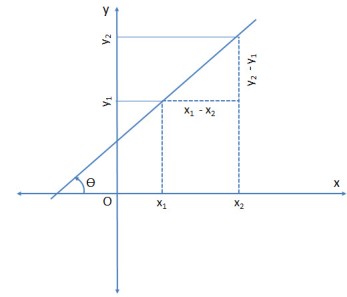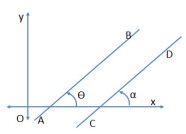Basic Concept of a Line
- Any point, that satisfies the equation of a line, will lie on the line.
- Also, any point through which a line passes, will always satisfy the equation of that line.
- Every straight line can be represented by a linear equation in two dimensions (
plane).
Inclination of a Line
The angle that the line makes with the
is called the “inclination of the line”. The angle
is when measured in anti-clockwise direction the inclination is positive and if measured clock-wise then the inclination is negative.
Note:
- Inclination angle
for
is
. Also all lines parallel to
will also have the inclination angle as
.
- Inclination angle
for
is
. Also all lines parallel to
will also have the inclination angle as
.
Slope (or Gradient) of a Line
The slope of the line is the tangent of its inclination and is denoted by i.e. Slope
Therefore
Slope of the
Slope of the (not defined)
 The slope of the line is positive if the line makes an acute angle with
The slope of the line is positive if the line makes an acute angle with when measured in anti-clock wise direction i.e.
is positive.
The slope of the line is negative if the line makes and obtuse angle with when measured in anti-clockwise direction. i.e.
is negative.
Formula for “Slope of Line passing through two points”
Let the two points be and
Parallel Lines
 Two lines having inclination as
Two lines having inclination as will be parallel if
i.e. slope of the two lines is equal and hence they are parallel lines.
Perpendicular Lines
 Two lines having inclination as
Two lines having inclination as and
will be perpendicular if:
or where
are slopes of the two lines respectively.
Note:
- If two lines are perpendicular, then the product of their slopes is
. Conversely, if the product of the two lines is
, they are perpendicular.
- Example: If the slope of a line is
, then the slope of another line parallel to this line would be
. Also the slope of a line perpendicular to this line would be
.
- A line whose slope is
, is parallel to
.
- Also the slope of
is not defined, all likes parallel to
will have slope which is not defined.
Condition for Collinearity of Three Points
Let there be three points
If the slope of segment AB and BC is the same, then they are all on the same line and are collinear.
X-intercepts & Y-intercepts
Refer to first figure.
If a line meets the , then the distance from origin to the point of intercept is called
.
Similarly, if a line meets the , then the distance from origin to the point of intercept is called
.
Equation of a Line
Slope-Intercept Form: When the slope is given and the intercept on the
is given.
The the equation is: where
is the slope and
.
Point-Slope form: When the slope of the line and a point on a line is given
The equation is:
Equally Inclined Lines
This means that the lines make equal angle from both the coordinate axes. As shown in the figure, lines are equally inclined.
For . Therefore slope
For . Therefore the slope



I see you don’t monetize your website, don’t waste your traffic, you can earn additional cash every month because you’ve got high quality content.
If you want to know how to make extra $$$, search
for: Boorfe’s tips best adsense alternative